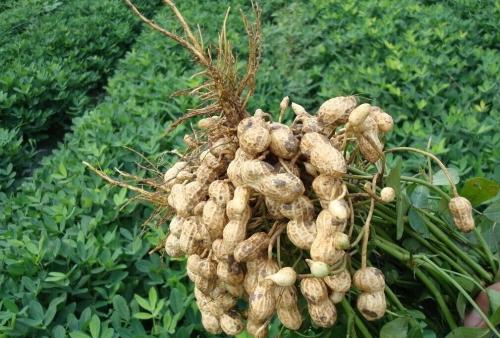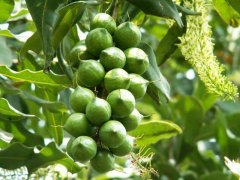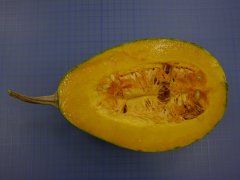Peanut planting method: peanut planting method and time of perennial peanut cultivation
Cultivation and utilization of perennial peanuts: do you know perennial peanuts? If you want to plant perennial peanuts, you must first understand it, know its growth habits and characteristics, which is of great use to planting. Let's take a look at it.
Along both sides of the first line of the highway from Chiayi to Xinyingtai, you can see the ground cover plant-perennial peanut, which adds yellow flowers to the earth. In addition to landscape ground cover plants, perennial peanut can also be used in orchard grass cultivation and green cutting fodder, which is a potential legume plant. These two varieties, which originated in South America, are rarely fruitful and are generally propagated by branch cuttings or stolons. This variety originated in Brazil and can be propagated by cutting seeds, stolons or branches. Its moisture tolerance and drought tolerance are better than A. glabrata. At present, local cultivation adaptability is evaluated in the Department of Agronomy and this field of National Taiwan University. This paper will make a brief introduction to the cultivation and utilization of perennial peanut Amaryl.

Plant character
The fresh seeds of perennial peanut Amaryl are dormant and can be treated at 35-40 ℃ for 10 days to break dormancy. The root system of the plant has been developed for many years, the main root is strong, and there is rhizobium symbiosis between the roots. With stolons and underground stems, the newly planted stems will first crawl and then grow erect, forming a dense turf about 20 cm thick. The leaves are pinnately compound, long oval and 4 leaflets, similar to edible peanuts. The flower is yellow, 12-17 mm long and 13-18 mm wide. The pedicel extends above the Corolla and blossoms throughout the year. The ovary stalk can extend more than 20 cm below the surface to develop a fruiting pod. Usually a pod has only one seed. The pod is 10-14 mm long and 6-8 mm wide. The seed is light brown, 8-11 mm long, 4-6 mm wide, and a hundred seeds weigh 11-20 mm. Diseases and insect pests rarely occur in the process of birth. Generally, turf can be formed about 6 months after planting, during this period, weeds must be controlled, and weeds can be effectively controlled after the turf is established.
Adaptability
Yamaliole peanuts have a wide adaptability, and their origin is located in central Brazil. the local climate belongs to a humid subtropical climate from October to May of the following year, with rainfall as high as 1800-2000 mm, while June to September is a dry period, with rainfall of only about 200 mm. Adaptability to these two different climatic environments is no longer a problem. From the past introduction experience, this variety can not only grow well when the annual rainfall is more than 1100 mm, but also has good drought tolerance. Although it has fallen leaves and grows slowly in the dry season, it can still survive in the dry season for more than 4 months. Grow again when the rainy season comes. It is usually grown on flat land in the tropics and subtropics, but it is documented that it can still grow well in coffee plantations in Colombia at an altitude of 1400 meters. The aboveground part will be necrotic during the frost period, but the underground part still maintains its vitality, and it will grow again after the frost period. The shade tolerance is strong, and the shaded environment grows better than the full sunshine environment, and the environment with a shading rate of 70% to 80% still grows well. For the soil selectivity is not strict, good drainage contains more than 3% of the sandy loam is the most suitable, and because of its symbiosis with rhizobium, it can fix nitrogen in the air, so the barren soil can also grow. Amarilla peanut can grow in acidic soil polluted by heavy metal aluminum and manganese, but it is sensitive to salt soil, and its growth will be inhibited or even unable to survive.
Use
First, ground cover landscape plants
As perennial peanuts are green and blossom all the year round, they can be used in sightseeing orchards of leisure farms or in flower beds, safety islands and highway slopes to add a beauty. Vetiver is planted on the slope of a highway in Malaysia to prevent soil collapse, and before the thatch hedge is formed, the intercropping of more peanut Amaryl can provide cultivation of thatch and cover the soil erosion ditch before the thatch hedge is formed, and the yellow flowers decorate the road, which is both practical and beautiful.
2. Grass cultivation in orchard
More and more attention has been paid to the use of ground cover plants as grass cultivation in orchards. In recent years, perennial peanut Amarole has been promoted to orchard grass cultivation in foreign countries, which has been quite successful as a cover crop. For example, in Hawaii, there are many coffee, bananas and palm orchards growing Amarilla peanuts. It has the characteristics of low creeping and can not climb, good drought and humidity tolerance, no commonality or host relationship with the main diseases and insect pests of fruit trees, and good shade tolerance. Once the turf is established, it can protect the soil for a long time and effectively control other weeds. In addition, it can symbiosis with rhizobium, fix nitrogen in the air and increase the source of soil nitrogen, which is the most suitable for soil application in which nitrogen fertilizer or organic matter is deficient. Moreover, the perennial peanut Amaryl is covered with the surface, which can intercept the raindrop attack, not only inhibit soil erosion, but also control weeds and reduce management costs, but also increase soil organic matter and root system decay in the process of metabolism. increase soil porosity, improve soil permeability and Rain Water infiltration rate, improve soil physical and chemical properties, ease the changes of microclimate and ground temperature, and benefit the growth of fruit trees.
III. High quality leguminous forage
The development of animal industry of herbivores such as cattle, sheep and horses depends on the supply of excellent forages. Legumes generally contain high protein, minerals and total digestible nutrients, which are conducive to the growth and development of herbivores. For dairy cattle, it can also improve lactation yield and milk quality, so high-quality forage grass is very important for the development of animal husbandry industry. On the other hand, most of the forages in Taiwan are grasses, and legumes rely on imports. If legume grasses can be effectively developed and mixed with legumes, the yield and quality of herbivores will be greatly improved, and the ecology of forage land can be more balanced. Amaryl, a perennial peanut, is a high-quality tropical or subtropical perennial legume, which can be harvested to prepare hay and silage, and is also suitable for grazing. It can be planted not only alone, but also mixed with perennial grasses. The digestibility in the test tube is as high as 600.76%, the nitrogen content is 2.3-3.0%, the phosphorus content is 0.18-0.37%, and the nutritional value is high, which can supply the growth demand of cattle at any stage.
Cultivation and management
The cultivation and management of perennial peanuts varies according to their uses and planting methods, as well as according to environmental, climatic and soil conditions. According to foreign research reports such as Costa Rica and Colombia, perennial peanuts have a seed yield of about 200,000kg per hectare. For seed sowing, it takes 20,25kg seeds per hectare, a row spacing of 50 × 30cm and a planting depth of 2cm. Soil must be covered to ensure germination rate. It is true that planting perennial peanut Amaryl in China can successfully blossom and pollinate seeds, but the experimental data on seed production are not yet complete and must be further discussed to facilitate popularization. at present, most of them are propagated by cutting stolons, and the cultivation and management covered by orchards are explained as follows:
I. planting season
After weeds are removed in the orchard in the warm season from late spring to early summer, the soil can be kept moist. If there is not enough water to irrigate, plant it when the rainy season comes to facilitate the establishment of turf.
II. Planting methods
Because the perennial peanut is planted in the orchard, the soil is not loosened, so cutting is more suitable than spreading. The stolon for cutting is 15 to 20 cm, and close planting is adopted to facilitate the rapid establishment of turf. Generally, it is recommended that the row spacing is 20 cm and the plant spacing is 15 cm. The stolon is buried in the soil about 5 cm, and the cutting is fully irrigated at the initial stage to improve the survival rate of cutting.
III. Fertilization
In general, there is often excessive fertilizer application in orchards, and whether grass cultivation should be supplemented depends on the growth status of fruit trees. usually perennial peanuts can fix nitrogen in the air and intercept nutrients lost or leached from the soil. No additional fertilizer is needed.
IV. Weed control
In the early stage of growth, weeds should be pulled out, the competition of weeds should be reduced, and the surface cover should be accelerated. Broad-leaved weeds can use a lawnmower or sickle to cut grass about 10 cm above perennial peanut plants, and the coverage rate can reach 90% in about 3 months. After the perennial peanut turf is established, it will effectively inhibit the growth of other weeds.
V. matters needing attention
The growth of perennial peanuts slowed down significantly after severe drought. These bad peanuts can be cut first and then regenerated can return to normal vitality. In arid areas, annual or biennial fruit trees do not have sufficient water for irrigation, perennial peanut planting should not be too close to the trunk of fruit trees, in order to reduce the impact on fruit trees.
At present, the popularization and utilization of perennial peanut is not popular in China, the main reason is that it is not so easy and fast to propagate by stolon, and how to save labor, management and maintenance after the establishment of ground cover plants is a problem. These aspects need to be further discussed and solved by research units. However, there is no doubt that it is indeed a leguminous plant with utilization value. in the future, if we can overcome the difficulties in seed collection and replace stolon cutting propagation with a large number of seeds, it is bound to solve some problems of high cost and low survival rate in cultivation, and relatively economic cultivation efficiency will be improved. It can be expected that perennial peanut will become an important resource in Taiwan's leisure landscape industry.
- Prev

How much is a pound of macadamia nuts in 2018? Yunnan macadamia nut unified open garden price plummeted picture
The latest news is that Yunnan has vigorously promoted macadamia nut cultivation in recent years and will hold a global nut conference next month. In the next few years, China will become the world's largest macadamia nut grower. This year's harvest season has begun, however.
- Next

Which pumpkin variety is the best? Is the new pumpkin variety Youwang seed on the market a new pumpkin variety with high yield?
It's so hot! Hualien Farm pumpkin variety Youwang seed is about to be on the market. Will you buy this pumpkin seed? Let's take a look. Disease resistance of African disease-resistant wild pumpkin was introduced into traditional papaya-type pumpkin by traditional backcross breeding to make new varieties.
Related
- The first cup of black tea in spring, the flavor and history of tea gardens in Kenya, Africa
- The computer can not only choose potatoes, but also grow tea rice. AI will grow winter oolong tea champion.
- It is not only the inflated tea bitten by insects, but also engraved with the four seasons tea in Beipu.
- The Oriental Beauty Tea Festival in Zhuxian County takes the stage at the weekend to experience the plus-size feast of oil tea.
- & quot; Oriental Beauty Tea & Exploration of Emei in Hsinchu, the hometown of quot;
- The new variety of strawberry "Tainong 1" dessert is the first choice with mellow aroma. Crimson gorgeous
- History of Tea in Taiwan: from Wild Inner Mountain to Export Tea Garden
- Two types of Taiwan Oriental Beauty Black Tea won the British three-Star Award for Childhood Tea Xiang Zhang Jiaqi changed from pilot to champion tea maker.
- Banana species and varieties: the planting history of Taiwan Xianren banana and dwarf banana is long, is banana disease resistant?
- Coffee planting Technology: Qianjie Coffee from Seedling to harvesting

